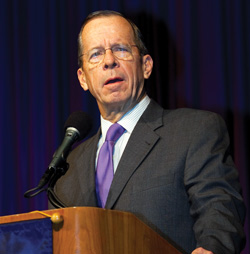Financial Considerations May Define Future Warfighting Capabilities
 |
Former chairman of the Joint Chiefs of Staff Adm. Mike Mullen, USN (Ret.), delivers some sobering assessments of the military’s future at West 2012 in San Diego, California. |
The defense budget cuts proposed for the foreseeable future offer the potential for both weakening the military and triggering a renaissance in innovation. And, that is just for the current reductions in the budget; if further draconian cuts are imposed, then no amount of innovation will make up for what some experts describe as a devastating evisceration of U.S. defense capabilities.
Many officials agree that the burgeoning U.S. national debt is a national security threat of its own, and it must be addressed decisively. Yet, these same officials warn that if the military is forced to cut $500 billion in addition to the planned $480 billion over 10 years, it would suffer significant losses in capability. Its ability to carry out its missions would be permanently damaged.
As such, hard decisions must be made by the military as it shapes the future force. These decisions must weigh new operational profiles and missions against the backdrop of scarce resources. And, this yet-to-be-determined future force must be flexible enough to respond to changes in enemy doctrines and tactics.
These and other points were emphasized by a range of speakers and panelists at West 2012, co-sponsored by AFCEA International and USNI. Held January 24-26 in San Diego, California, the conference’s usual nautical theme this year was supplanted by a broad look at the future of the military.
Vice Adm. William E. Gortney, USN, director, the Joint Staff, described the nation’s financial crisis as a “strategic vulnerability,” and he said the Defense Department must join the rest of the country in belt tightening. Former chairman of the Joint Chiefs of Staff Adm. Mike Mullen, USN (Ret.), echoed Adm. Gortney’s warning, adding that the worse the national debt grows, the smaller the Pentagon budget becomes and the less likely the United States can deploy the forces it needs.
One of the capabilities that was discussed was special operations, and the commander of the U.S. Navy Special Warfare Command (NSW) described how special operations forces (SOFs) can help achieve a multitude of military objectives. Rear Adm. Sean A. Pybus, USN, said that SOFs are likely to play a greater role in Southwest Asia.
These SOFs will require new technologies, the admiral noted. He cited better intelligence, surveillance and reconnaissance sensors and platforms; the ability to communicate in a contested environment anywhere in the world, including through adversary electronic warfare; individual soldier systems for personal self defense; and a “thick network” to serve small groups in hostile areas.
Lt. Gen. George J. Flynn, USMC, director, J-7, the Joint Staff, supported Adm. Pybus’s statements about the role of SOFs, and he added that the military must do what it needs to do by using what it has. The general offered a pointed observation that adversaries may turn out to have the most cost-effective approach to warfare as they seek an adaptive advantage through asymmetry.
That asymmetry may manifest itself in cyberwarfare, and providing security for cyberspace may suffer the same budgetary limitations as other elements of the military domain. A panel of experts emphasized the need for innovative thinking when it comes to information security—both for necessary savings and for effective measures against intruders.
The growth of networks has increased the emphasis on information assurance, noted Rear Adm. Jerry K. Burroughs, USN, program executive officer for C4I. Calling information assurance his top priority, the admiral also cited the need for improved two-way communications.
No discussion of military capabilities and requirements can take place without a look at potential conflict points, and several speakers and panels at West 2012 considered a wide range of possibilities.
As expected, China was a focus of discussion. While many experts disagreed on the state of affairs between China and the United States, all suggested that the United States continue to advance dialogue between the two Pacific powers. Several experts warned against adapting Cold-War-style approaches for China, as the Middle Kingdom is not the Soviet Union, and the Sino-American relationship is far different from the Soviet-American confrontation.
In-depth coverage of West 2012 is available online at http://bit.ly/uRIhrm .




Comments